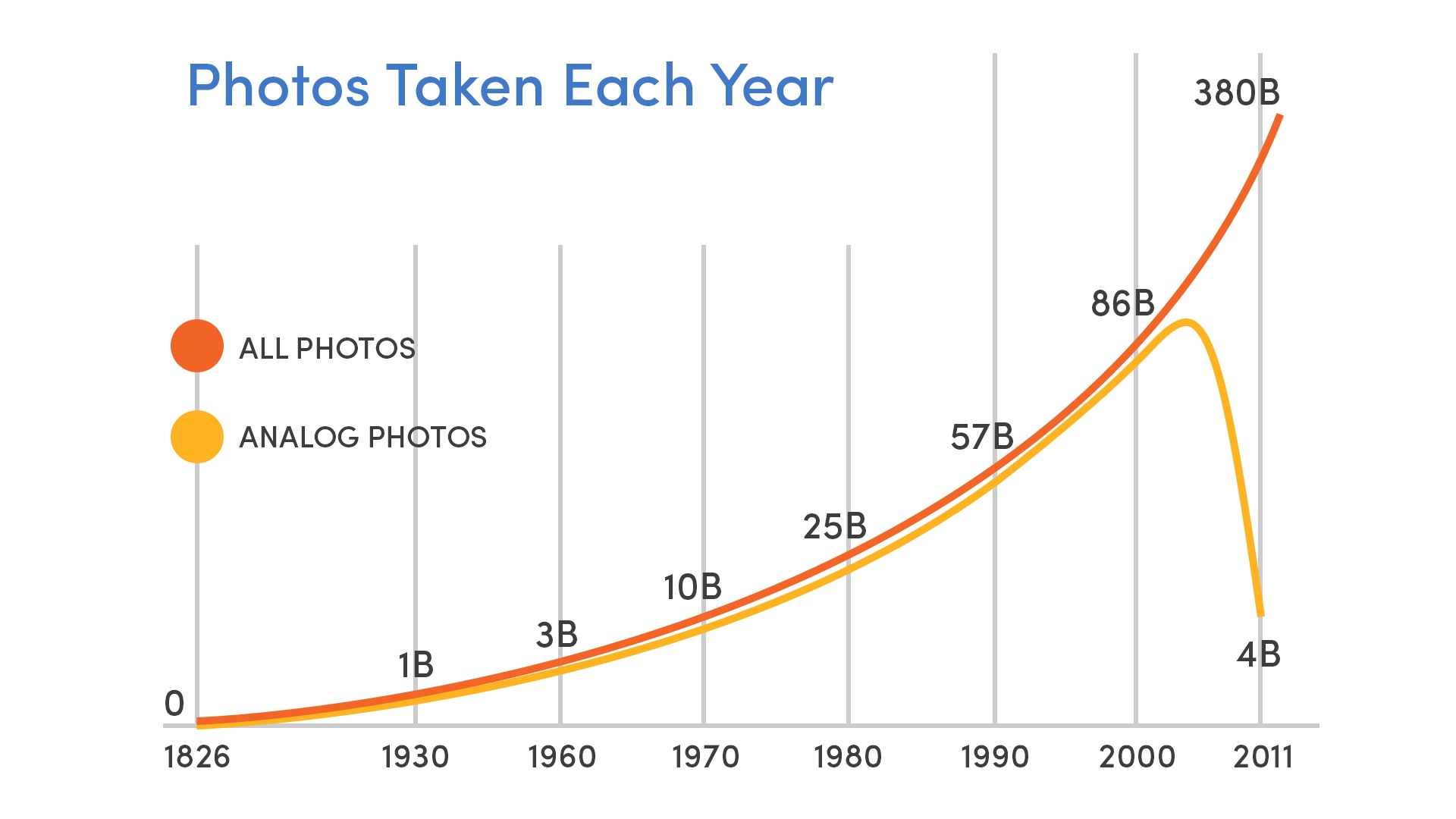
This blog is about how to not to be disrupted and, perhaps more importantly, how to disrupt yourself before someone else does.
I had the chance to sit down with Ed McNierney, who came out of Lotus 1-2-3 and ran Digital Strategy at Kodak. Over the years, he has learned a lot from both Lotus and Kodak’s failures.
Ed brings 30 years of wide-ranging technology expertise to the table – and he’s seen a lot of unintended disruption.
P.S. Send any tips to our team by clicking here, and send your friends and family to this link to subscribe to Abundance Insider.
Who is Ed McNierney?
In the late 1980’s, Ed led the development of Lotus 1-2-3 for Windows in an attempt to compete with the highly disruptive Microsoft Excel (I’ll share the full story in a minute).
A few years later, he ended up leading Digital Strategy at Kodak. He didn’t last long; Ed left when he experienced firsthand Kodak’s unwillingness to change, rapidly racing into a brick wall of bankruptcy in 2012.
He’s been through several “disruptions” in his own right and has learned a lot along the way.
We’ll get into the Do’s and Don’ts from Ed’s experience in a minute -- but first, a bit of history and context about Lotus and Kodak.
History – Context Around Lotus and Kodak
In the 80’s, Lotus was the Google of its day -- it was the software company.
Its core product, Lotus 1-2-3, was the killer app: it was the reason people bought PCs.
In parallel, Lotus saw that Microsoft was developing Windows and another product called Excel.
The Lotus team saw the incoming threat of Windows, but thought if they ignored Windows and didn’t build apps for it, everyone else would stay away from Windows, too.
Instead, their biggest customers -- Procter and Gamble, Exxon and Shell, among others -- thought differently. They were leaving Lotus and going to Windows/Excel.
Then Lotus rushed to bring a product to market.
But they made a fatal mistake: instead of looking only forward, they made their product entirely backwards compatible, or compatible with their past.
Meanwhile, Microsoft focused 100 percent on building a great Windows spreadsheet, compatibility be damned.
Lotus’ strategy didn’t work. They couldn’t keep up. Complete disruption.
The company was ultimately acquired by IBM in 1995 and, today, no longer has a product line.
Now, let’s look at Kodak:
Shortly after Ed left Lotus, he joined Kodak as its VP of Digital Strategy.
This was 1996, the heyday of Kodak.
Kodak had a $28 billion market cap and 140,000 employees.
In 1976, 20 years earlier, Kodak had invented the digital camera. They owned the IP and had the first mover advantage. This is a company that should have owned it all.
Instead, in 2012, Kodak filed for bankruptcy, put out of business by the very technology they had invented.
What happened?
Kodak was married to the “paper and chemicals” (film development) business… their most profitable division, while the R&D on digital cameras was a cost center.
They saw the digital world coming on, but were convinced that digital cameras wouldn’t have traction outside of the professional market.
They certainly had the expertise to design and build consumer digital cameras -- Kodak actually built the Apple QuickTake (see photo), generally considered the world’s first consumer digital camera.

Ed McNierney holding Apple QuickTake (by Kodak)
Amazingly, Kodak decided they didn’t even want to put their name on the camera.
What happened next? The “digital movement” decimated them... they simply couldn’t keep up and, as mentioned, filed for bankruptcy in 2012.

Graph: How the digital movement decimated print photos
It’s difficult to create change in a large organization steeped in tradition, and even harder to disrupt yourself when you’re cranking out cash the way Kodak was.
But you have to disrupt yourself, or someone else will.
During his time at Lotus and Kodak, Ed learned a lot about what not to do.
Here are 8 things you shouldn’t do if you want to avoid disruption.
Eight Don’ts – How Not To Be Disrupted
- Don’t close out your options too early: For Kodak, they decided they weren’t going to be in the digital camera business. As a result, they stopped devoting resources to digital before it was too late. Don’t eliminate new products, new markets and new opportunities from your possible pipeline.
- Don’t be tied to your history: As Ed relayed, “You have way more ahead of you than behind you... bringing the dead weight of your legacy from your past into the future can be detrimental to the business.” Just because Kodak was in the paper-and-chemicals business doesn’t mean they can’t be something else.
- Don’t be overly attached to your existing business: All existing products/services will be disrupted, and revenues will eventually go to zero. Don’t be attached to them. You have to move with technology and the market. This is hardest when you are profitable, like Kodak. You must be aware that you’re most vulnerable when you’re doing well.
- Don’t ignore the signals: Ed mentioned, “It’s easy to see that little disruptive force on the horizon and think to yourself, “Boy I hope that thing goes away,” or, “I hope if I ignore that, it’s just not going to happen.” Don’t ignore them. Your biggest threats are probably in the deceptive phrase.
- Don’t be tentative: Kodak built the first digital camera. But they were tentative. They didn’t want to put their name on it. Don’t be tentative; be bold. Don’t play defense – spend money on accelerating (we’ll get to this in a second).
- Don’t say, “We can’t do X because it is not the way we do things”: “It’s not the way we do it” is never a good enough argument NOT to try something new...
- Don’t worry about the big guys: When looking at potential disruptions, don’t worry about the big companies. They are usually (with some exceptions) slow-moving and tentative, ironically enough (see Kodak and Lotus). Instead, you should be worrying about the small guys in a garage. They have nothing to lose. Try to find them... invest in them, partner with them or hire them.
- Don’t fret! You are fighting against billions of years of human evolution. We have evolved to be linear thinkers. Just keep trying to innovate and avoid doing the things above. And keep reading.
Now let’s talk about a few things you CAN do to disrupt yourself.
Six Do’s of Disruption: How to Disrupt Yourself
- Disrupt your adjacencies: It’s hard to disrupt yourself; few companies have ever done this. So instead, try to disrupt your suppliers and/or your customers. You can disrupt your suppliers by vertically integrating and building business around the systems that power your existing business. You can disrupt your customers by looking at the other products and services they are already using and build better ones. Apple, Amazon and Google are all great at both of these.
- Build the best products, or get a piece of them: The best product wins. Either build the best product in your category, or if you can’t, find a way to get a piece of the best one.
- Be agile: Agility is everything. Make sure you have the right culture and people to support agility. Oftentimes organizations have an immune response to new innovations – instead, try to make innovation and change a part of your culture.
- Watch your customers, then listen to them: It sounds intuitive, but it’s not. As Ed mentioned, Lotus saw that their customers were switching to Excel. Then they heard them say they preferred it. And yet they didn’t do much about it. Your customers are your lifeblood. Listen to them and adapt to them.
- Build a Skunkworks: Ed mentioned, “I would have loved to have had a business inside Kodak whose job it was to totally destroy the core business.” I’ve talked about this idea before – you need to create a safe, secure place for innovation to happen.
- Have an abundance mindset: As Ed puts it, “There is more ahead of you than behind you.” Don’t be afraid to reinvent yourself.
Also read: TOP 50 MOON SHOTS (2000 - 2020)
WHAT IS ABUNDANCE INSIDER?
This email is a briefing of the week's most compelling, abundance-enabling tech developments, curated by Marissa Brassfield in preparation for Abundance 360. Read more about A360 below.
WANT MORE CONVERSATIONS LIKE THIS? - JOIN ME
At Abundance 360, Peter's 360-person executive mastermind, we teach the metatrends, implications and unfair advantages for entrepreneurs enabled by breakthroughs like those featured above. We're looking for CEOs and entrepreneurs who want to change the world. The program is highly selective. Apply now for Abundance360 Summit if you'd like to develop an Abundance mindset.
Know someone who would benefit from getting Abundance Insider? Send them to this link to sign up.
P.S. I've just released a podcast with my dear friend Dan Sullivan called Exponential Wisdom. Our conversations focus on the exponential technologies creating abundance, the human-technology collaboration, and entrepreneurship. Head here to listen and subscribe.







